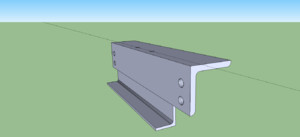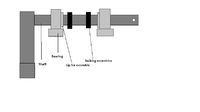CEB Press/Manufacturing Instructions/Soil Shaker
Jump to navigation
Jump to search
Tools Required
- Welder
- Torch
- Hole punch with, 1/2", and 13/16" dies.
- Drill Press with 3/8" bit
- 3/4" wrench
- Adjustable wrench
- Angle Grinder
Materials Required
Steel
- 4"x4"x1/2" Angle: 29" total
- 8" Piece: Motor attachment
- 21" Piece: Hopper attachment
- 2"x2"x1/4" Angle: 52"
- Top and Bottom Pieces: 16" (2)
- Side Pieces: 10" (2)
- 1" Rebar: 14" total: 7" (2): Braces
- 1" DOM Roundstock: 7.25", shaft
- 1"x2" flatbar:
- 5", hammer handle
- 6" hammer top
- 1/8" sheet: 10"x19"-Guard
Nuts and bolts
- 3/8"x2.5" bolt (1)
- 3/8" washer (1)
- 3/8" lock washer (1)
- 3/8" lock nut (1)
- 1/2"x1 1/2" bolt (6)
- 1/2" nylon lock nut (6)
- 1/2" washer (6)
- 1/2" lock washer (6)
Other
- 1"x2"x5" eccentric pillow bearings with locking eccentrics.
- 1" to 1" coupler to fit motor
- Soil Shaker motor unit
Diagrams
Fabrication Steps
Mount
Guard
- Torch the guard sheet metal as in the image. It doesn't need to be exact.
- Weld the angle to it as shown.
Main Mount
- Punch the all holes in the 4x4 angles.
- You may need to torch some as they're hard to access.
- Torch a hole for mounting the motor in the 8" piece of 4x4 angle. Grind off the slag.
- The center of the hole should be 1 3/4" away from the corner of the angle.
- You need to ensure the hole is large enough so that where the bolt holes are will be touching the angle when in place. The motor is most likely raised in the center.
- You can torch separate holes for the bolts, or do one large, odd shaped one like is pictured.
- Weld the bottom 2x2 to the 21" 4x4.
- Weld the two 4x4 angle pieces together as pictured, ensuring they are perfectly flush and square. Skip around while welding so it doesn't warp one way or another.
- Grind off the center of the weld on the top side, where the pillow bearing will go.
- Weld the rebar onto the underside of the mount (see photo.)
- Weld the guard to the top of the mount.
Bolt shaft to coupler
- When the mount is welded together, attach motor to the mount and coupler to motor.
- Make sure the coupler won't be rubbing on mount while it spins.
- Put the shaft into the coupler and mark on the shaft how far it goes into the coupler.
- Remove the assembly from the mount.
- Drill the 3/8" hole thru the coupler and rod, using the mark you made to make sure the rod is inside the coupler the proper amount. The hole should be far enough from the end of the rod so its at least 3/8" away from its end, and equally far from the edge of the coupler.
- Drill thru both at the same time. You will need some sort of vice to hold it down while you drill.
- Double check that your bolt will fit thru. If not, either re-drill it with a slightly bigger bit, or do another set of holes.
The Hammer
- Drill or punch a 1" dia. hole centered, about 1" away from the end of the 1"x2"x5" flatbar.
- Weld the 5" piece perpendicular to the center of the 6" piece, as shown.
![]() Warning: This weld needs to be SOLID, or the hammer might fly off and KILL you. Do at least 2 thick passes, and you may even want to bevel where they meet so you can get some bead in between them
Warning: This weld needs to be SOLID, or the hammer might fly off and KILL you. Do at least 2 thick passes, and you may even want to bevel where they meet so you can get some bead in between them
- Put the shaft into the hole, so that its 3/4" inside of it, leaving about a 1/4" space to plug weld it.
- Plug weld the shaft in place (Make sure your hole for the coupler isn't inside the hammer, but on the opposite side.) and weld the top side as well.
Assembly
- You probably want to wait to assemble it until you have welded the mount bolts to the hopper legs, but it can be before, too.
- Loosely bolt the motor (needs to have hydraulics ready, see Soil Shaker motor unit) to the mount, with a washer and a lock washer on the side of the nut, and a washer on the other side if necessary.
- Put the bearings onto the shaft, ensuring the eccentric side is facing inwards, and remember to put the eccentrics in.
- The eccentrics are little collars with lopsided circles inside of them. This makes it so it can lock into the bearings.
- Ensure both collars are facing the right direction (So it will lock onto the lip) and so are the bearings.
- Put the coupler onto the shaft. Make sure you can see thru the holes, (it could be off 180 degrees and a little crooked) then put on the bolt, lock washer, and lock nut.
- Couple it to the shaft of the motor now, tightening down the set screw.
- Tighten the motor mount bolts.
- Position the bearing closest to the motor over its holes and put in a bolt with a washer, lock washer, and lock nut on the other side. Tighten these down.
- Insure the hammer rotates freely still. It may require some force, but shouldnt need much.
- If the hammer won't rotate, loosen the motor mount bolts, retighten them, and recheck it.
- Position the other bearing and tighten it down, still insuring it will rotate without much force.
- Lock the eccentrics by pushing them towards the lip on the bearing and twisting it.
- Tighten the set screw on the eccentrics.









